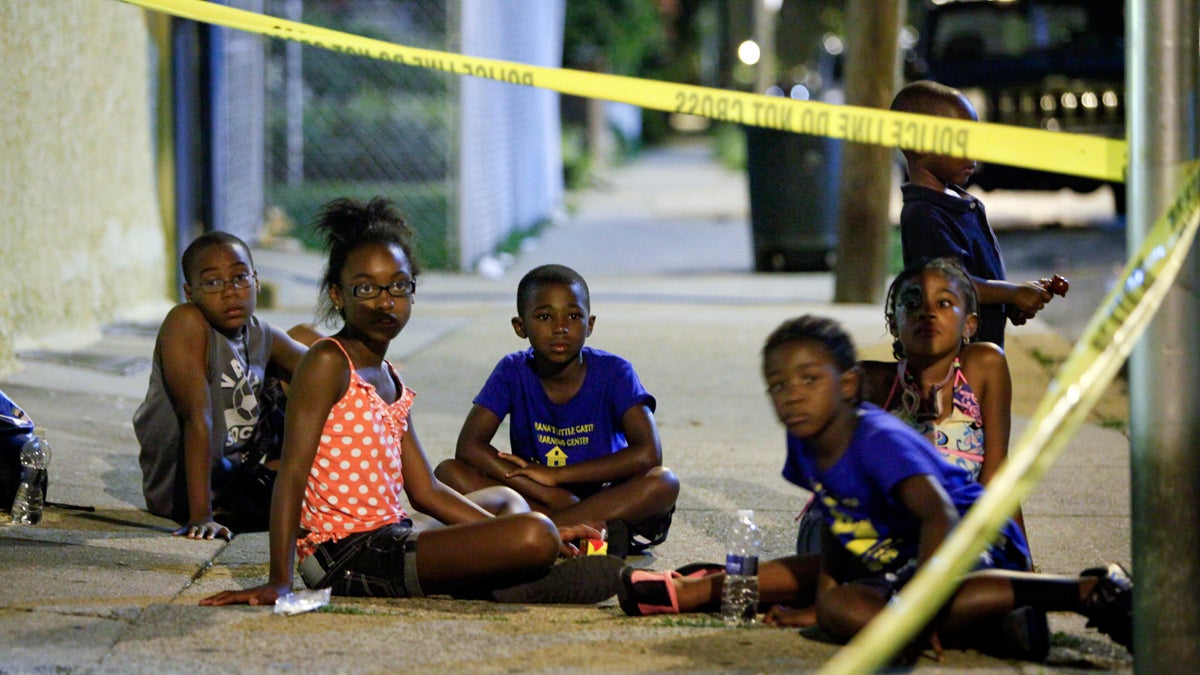Changing the conversation about gun violence — lessons learned from Philly’s Gun Crisis Reporting Project

Children from Treana's Little Castle Learning Center watch police officers as they investigate a crime scene in the East Mount Airy section of Philadelphia on Friday July 27, 2012. (Photography by Joseph Kaczmarek, courtesy of GunCrisis.org)
Philly Gun Crisis Reporting Project editor Jim MacMillan discusses the ongoing problem of gun violence and lessons other cities can take away.
The Philadelphia Gun Crisis Reporting Project, made up of independent journalists documenting nearly every incident of gun violence in the city since 2012, stopped daily operations recently due to lack of funding. The group still plans on sending a monthly newsletter and is having discussions with other organizations about the future of the project. We caught up with editor and co-founder Jim MacMillan about the ongoing problem of gun violence in Philadelphia and lessons other cities can takeaway from the two-year reporting project. The following interview has been edited for clarity and brevity.
Q: What is the Philly Gun Crisis Reporting Project and why did you start the project?
A: The Gun Crisis Reporting Project is a small independent non-profit journalism organization focused on seeking solutions to the epidemic of gun violence in Philadelphia. In Philadelphia, we suffer from the highest rate of homicides in large American cities. Small cities have higher rates and different problems, but we’ve got a big problem and we need to fix it.
I have a lot of background covering gun violence. I was a photographer for the Philadelphia Daily News for many years, specializing in what journalists call spot news or breaking news. In other cities, that is often fires and accidents. In Philadelphia, it’s mostly gun violence.
The turning point came when I learned about public health intervention strategies to stop gun violence at a conference … on best practices for reporting on youth violence. Since then, I’ve learned about interventions coming from the field of criminology, that are similarly if not more effective. For me, I’ve lived in Philadelphia for almost 25 years. I love the city and I left that conference feeling as if I imagine one might feel if they had a loved one with a terminal disease and met a room full of people with the cure. We know how to stop this and I want to tell everybody.
Q: How is the Gun Crisis approach different than what we see on the evening news or read in the newspapers?
A: Most of the coverage you see in local news gives you a play by play. A young man, most often of a certain age was shot so many times at the corner of this and that at some time and rushed to this hospital in this condition. We are never going to check in again because we specialize in breaking news and we are going to give you that same report on the next guy. Very little reporting focuses on the cause or the solutions and a lot of people are misinformed about the roots of gun violence and about our ability to stop it.
Q: What intervention strategies have proven most effective over the course of the Gun Crisis Project?
A: Most of the effective strategies can be traced back to the fields of criminology or public health, although they employ many of the same tactics. They include engaging the men, this is mostly a male problem, at the front lines of gun violence in American cities and helping them understand the ramifications of their actions and the alternatives to acting out violently.
In terms of ramifications, shooters aren’t always thinking that they’re not harming only their adversary, but themselves, and their families, and their communities every time that they pick up a gun, every time that they pull the trigger — that everybody pays. And in terms of alternatives, very often when human beings act out violently they have the sense that they are alone, that they have nobody to turn to. So, community support goes a long way. But you can also very directly teach people conflict-resolution, conflict-avoidance, situational awareness and find ways to avoid getting into the confrontation to begin with and getting out of them without pulling the trigger.
It’s not always easy, but it doesn’t always take much. Sometimes it’s human nature. Sometimes it’s as simple as a cooling off period. Sometimes it’s as simple as taking the guy to dinner and having those conversations about ramifications and alternatives. It’s very important in urban culture in America to defend one’s integrity — to defend one’s reputation. But there are other ways and solutions to doing that. There are other alternatives to find respect without bringing so much harm to so many people.
Q: Are there any groups in Philly that you think are doing a good job addressing this issue and that their message needs to spread?
A: In Philadelphia, there is a broad spectrum of heroic groups and individuals working to reduce gun violence.
Coming from the field of public health the Philadelphia Ceasefire intervention program at Temple University has been working for several years. For instance, in the 22nd Police District in North Philadelphia they had evidence of greater than a 20 percent reduction in gun violence in the first year they were engaged there.
In South Philadelphia last year, the police department began working with community leaders in a program that was called Focused Deterrence. In this model, the police worked to identify individuals and networks associated with gun violence. Like the Ceasefire program, they try to provide alternatives to violence. They say, ‘we can see where you’re involved in this network responsible for past gun violence. This makes you more likely to do it again, so we want to create opportunities for you to get out. And those opportunities include jobs and job training.’ At the same time, there is some discussion of enhanced enforcement. If there is continuing gun violence, they might see the same kind of enforcement they remember seeing if a child is shot or a police officer is shot. What both programs have in common is a focus on alternatives and ramifications.
Another important program I followed and reported on is Mothers in Charge, a group of Philly’s bereaved by violence – most often gun violence. They work in prisons with men and women about to return to their communities after spending some time in incarceration. They teach conflict-resolution and avoidance skills. So people return to their communities with the tool kit to avoid more violent crime.
Q: On a personal level, are there any individual cases that have stayed with you during this project?
A: A lot of incidents stay with me. There are so many it would be unfair to select a few. Recently a 15-year-old girl was shot and killed in Olney by a stray bullet in a sudden outburst of gun fire that left another person critically wounded. But that is just one of many. I guess the children stay with you in particular — of course. Really, what stays with me above all is the volume. The constant and it hasn’t stopped. I find my email full of terrible news every morning. It’s a torrent. It’s a river of suffering and trauma and we have the science to stop it.
Q: What changes have you noticed over the past two years by focusing on this issue?
A: Something historic has happened. We’ve seen a 25 percent reduction in homicides in Philadelphia and there are a lot of forces at play. The only thing we know for certain is that everybody can’t have all of the credit. What sticks with me the most is the number of heroic individuals and great organizations working to stop gun violence — public health intervention workers, volunteers, community groups, police, of course, some scholars, and some legislators. But above all, I think we have to attribute that to the people who are brave enough to put down the guns. It’s not easy to decide to be stronger and do something different.
Q: What do you think other cities, especially smaller cities in Pennsylvania, can learn from the Philly Gun Crisis Project?
A: I think above all, we learned that we have a city hungry for solutions. We were only a few months into this project when I got a call from City Hall to bring our team and report on solutions to Philadelphia City Council. In fact, they had us in twice. For years, I’ve heard this tone of, ‘somebody’s got to do something, this can’t go on.’ But now, I’m hearing more, ‘look what’s working over here, we have to do more of that. We’ve got to get together and work on a change.’
There is also an undeniable movement toward evidence-based programs and at the same time I suspect there are a lot of community-based programs that have a lot of impact and to get funding now, you need to learn to assess, gather evidence, and report on your impact. And I think there are lots of people out there that know they’ve had impact, just by intervening and helping one person in crisis to keep from pulling the trigger. And yet they haven’t had the skills, training, or resources to gather that evidence to get more funding. So, on one hand I’m enthused about evidence-based programs. On the other hand, I’m worried that it will work to the disadvantage of other impactful, but less formalized initiatives.
WHYY is your source for fact-based, in-depth journalism and information. As a nonprofit organization, we rely on financial support from readers like you. Please give today.



